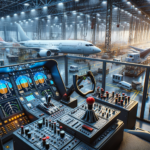Understanding the Fundamentals of Aviation Training
Aviation training is a comprehensive field that covers numerous aspects essential for ensuring safety and efficiency in the sky. At its core, aviation training equips individuals with the necessary skills and knowledge to perform various roles within the aviation industry. These roles range from pilots and flight attendants to air traffic controllers and ground crew. The training is structured to meet rigorous industry standards, ensuring that all personnel are well-prepared to handle the dynamic and sometimes unpredictable nature of air travel.
One of the primary components of aviation training is understanding the technical aspects of aircraft operation. This includes learning about aerodynamics, navigation systems, and meteorology, which are crucial for pilots. For flight attendants, training focuses on passenger safety, emergency procedures, and customer service excellence. Meanwhile, air traffic controllers undergo training in managing aircraft movements, both on the ground and in the air, to prevent collisions and ensure smooth operations.
The training programs are often a blend of theoretical instruction and hands-on experience. Simulators play a significant role in providing realistic scenarios without the risks associated with actual flight. Additionally, real-world training exercises are conducted to ensure trainees can apply their skills effectively. This dual approach ensures that all aviation personnel are not only knowledgeable but also competent in practical situations.
- Comprehensive understanding of aircraft systems
- Mastery of safety and emergency protocols
- Proficiency in communication and teamwork
Overall, aviation training is pivotal in maintaining the high standards of safety and efficiency that the industry demands. By thoroughly preparing individuals for their respective roles, the training ensures that the aviation industry continues to operate smoothly and safely.
The Role of Technology in Modern Aviation Training
Technology has revolutionized aviation training, introducing innovative methods that enhance learning and skill acquisition. One of the most significant advancements is the use of flight simulators, which provide trainees with a realistic flying experience without leaving the ground. These simulators replicate various flight conditions, allowing trainees to practice maneuvers, handle emergencies, and experience different weather scenarios in a controlled environment.
Moreover, virtual reality (VR) and augmented reality (AR) are increasingly being integrated into aviation training programs. These technologies offer immersive experiences that enhance understanding and retention of complex concepts. For instance, VR can simulate intricate cockpit environments, enabling pilots to familiarize themselves with controls and instruments. Similarly, AR can overlay digital information onto real-world settings, assisting trainees in visualizing and understanding aircraft systems.
Another technological advancement is the use of e-learning platforms and mobile applications. These tools provide flexible learning opportunities, allowing trainees to access course materials, videos, and quizzes at their convenience. This flexibility is particularly beneficial for those who need to balance training with other commitments.
- Enhanced realism with advanced simulators
- Immersive learning through VR and AR
- Flexible access to training materials via e-learning
Overall, technology in aviation training not only improves the learning experience but also ensures that trainees are better prepared to face real-world challenges. As technology continues to evolve, it will undoubtedly play an even more integral role in shaping the future of aviation training.
Career Opportunities and Growth in the Aviation Industry
The aviation industry offers a wide array of career opportunities, each with its unique set of challenges and rewards. For those who have completed aviation training, the possibilities are vast and varied. Pilots, for example, have the opportunity to work with commercial airlines, private charter services, or even freight carriers. Each of these paths offers different experiences and requires specific skills and qualifications.
Flight attendants, on the other hand, play a crucial role in ensuring passenger safety and comfort. With the right training, they can work for major airlines, enjoying the perks of travel and meeting people from diverse backgrounds. Additionally, roles such as air traffic controllers and ground crew are essential for maintaining the smooth operation of airports and airspace.
The aviation industry is known for its potential for career growth. With experience and additional training, individuals can advance to more senior positions, such as chief pilot, flight operations manager, or even transition into aviation management roles. The industry also offers competitive salaries and benefits, making it an attractive career choice for many.
- Diverse career paths in piloting, cabin crew, and ground operations
- Opportunities for advancement and specialization
- Attractive salaries and benefits
In conclusion, aviation training opens the door to a world of opportunities in a dynamic and ever-evolving industry. Whether you’re drawn to the skies as a pilot or prefer the operational aspects on the ground, aviation offers a rewarding career with the promise of growth and development.








